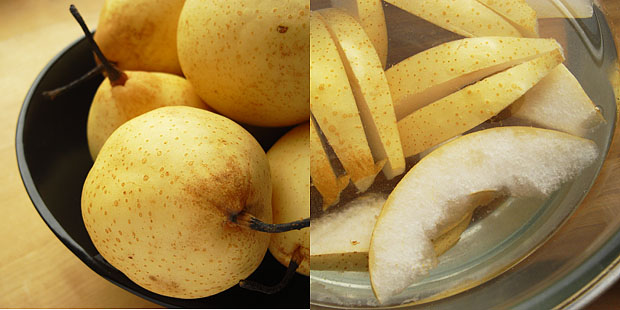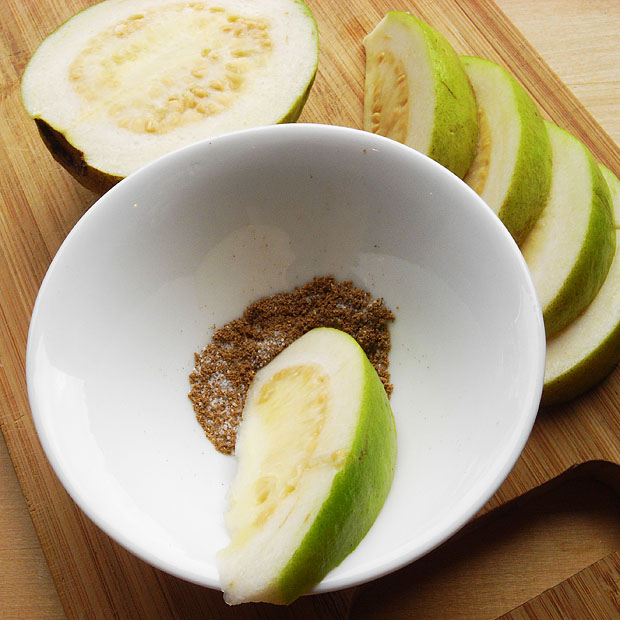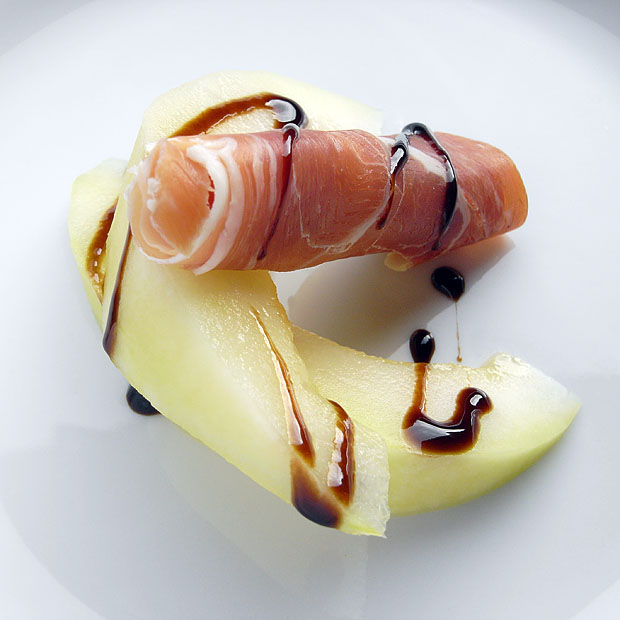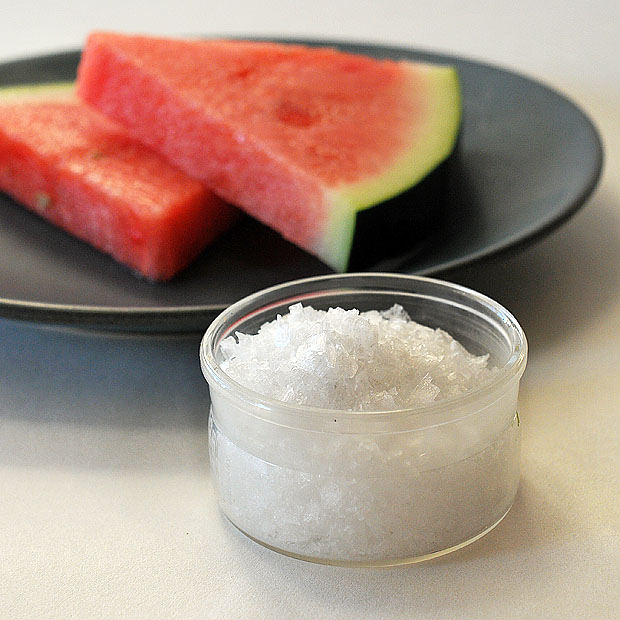
Salt helps to bring out the flavor of watermelon
In Asia it is not uncommon to eat fruit with salt or even soy sauce. From my own experience, and via friends, I known that fruits such as mango, guava, honey dew melon, watermelon, nashi pears and papaya are eaten with salt. Interestingly salt is used both for ripe and unripe fruit – the latter is especially the case for mango and guava. With unripe fruit I can imagine that the primary motivation is reduction of bitterness. I’ve previously blogged about salt and coffee and how salt in tonic water reduces bitterness – the mechanisms are the same. In addition to the bitterness suppression low concentrations of salt will enhance sweet taste. [1] This would certainly be an advantage in unripe fruit. In ripe fruit there is hardly any bitterness left (or at least I presume that is the case), so here the salt may serve a different funtion. Could it be to balance the sweet taste and give a more savory and complex flavor? Perhaps it could also be explained as increased sensing by contrast amplification?

Nashi pears (Asian pears) are delicious when served in a bowl of salty water!
One particular combination of fruit and salt that I remember from growing up in Taiwan is eating slightly unripe guavas with a beige powder. We would either sprinkle the powder onto the fruit or simply lick it from our hand. The powder had a savory flavor and was a little salty. I can’t remember the name, but from a couple of google searches I’m quite sure that it was a dried plum powder – li hing mui (or just li hing). I found a couple of blogs showing guava with plum powder and masala salt which suggests that there are probably several spice powders used together with guava. The Wikipedia entry on guavas also mentions them being eaten with soy sauce and vinegar (occasionally with sugar and black pepper) on Hawaii, and with a pinch of salt and cayenne powder/masala in Pakistan and India.

Guavas taste even better with a salty/savory dip! For the picture I combined ground star anis with salt and sugar.
As I started to search for combinations of fruit and salt I was overwhelmed by all the different combinations I found. Salt (and other salty food items) are often mixed with other ingredients such as chili or lime. Here’s a small selection of what I found in no particular order:
salt + sugar + chili (Prik-kab-klua)
salt + sugar + chili + lime (Muối ớt)
salt + chili sauce
salt + masala
salt + cayenne
soy sauce
soy sauce + vinegar (+ salt/pepper)
fish sauce
fish sauce + sugar + chili
fish sauce + black pepper
tajin = salt + chili + lime juice
kiam-muy-hoon/kiamuy
li hing mui (dried plum powder)
dried plum powder + sugar
bagoong (salted shrimp paste)
prosciutto
…

One of the few many salt + fruit combinations that has made it to Europe: prosciutto ham with honey dew melon (and some drops of balsamico syrup)
Other more specific fruit/salt/savory combinations I found were:
bananas and guavas with salt and fresh pepper (served in India)
chili salt with fruits such as Granny Smith apples, plums or oranges.
peaches with chili/lime/salt
pomelos with salt and red chillis
Hawiian margarita with Ling Hi Mui powder
…
It seems that eating fruit with salt is far more common in warm countries where an additional intake of salt is recommended due to perspiration. (Update: Lisa comments on her Swedish blog that it could be due to the fact that there are more supertasters in Asia – they are more sensitive to bitterness, hence the additional use of salt) And I admit that my craving for salt does increase when it’s warm. But there is more to this than physiology – the few combinations I have tried are indeed mouth watering – even when tested in cold Norway. And thinking about it, it is really fascinating how plain table salt – one of the simplest (chemically speaking) ingredients we have in the kitchen – has such a repertoire in combination with fruit. There is certainly a lot to try out in the kitchen now – and perhaps some inspiration from Asia for chefs as well?
If you know about or have tasted other fruit + salt combinations, please leave a comment in the section below 🙂

Reference:
[1] Keast, R. S. J.; Bresling, P. A. S. “An overview of binary taste-taste interactions” Food Quality and Preference 2002 (14), 111.

A very common confection in Mexico is dulce de tamarindo enchilado y salado, or salted tamarind candy with chili. As the name implies, it’s tamarind candy (all sorts, from hard suckers to chewy Pulparindo, similar to fruit paste) covered in a layer of chili powder (covering the gamut from just a slight chili flavor to quite spicy) and a little salt. Most Americans I’ve given the candy to find it disgusting, as did I at first, but the combination definitely has its merits.
I’ve been drafting a post on a traditional Thai snack which exemplifies this perfect fruit+salt combination. Will link to this. Thanks for the info. I always learn about the whys of food from you.
That’s true, in the Philippines. Mangoes are eaten with bagoong – shrimp paste. We eat almost any sour fruit with a little salt.
When my Mexican husband first dipped lemons, oranges, and watermelon in a chili-salt mixture, I thought he was crazy. But I’ve come around. It’s delicious!
My grandmother always served slices of ripe canteloupe-usually still warm from the field-with salt. That was in southerd Delaware (mid-Atlantic, US–think southern cooking). But the previous comment about candy brings to mind the salt licorice I’ve seen here in Germany and in the Netherlands.
Off the top of my head: in Italy: pears and cheese, strawberries and balsamic vinegar, “insalata di arance” (orange salad), mostarda mantovana (sweet fruit sauce with meat), pumpkin tortelloni (it’s a bit of a stretch as not everyone would think of pumpkin as a fruit, but the filling is sweet and the meat ragú is salty and savory).
In Mexico I also remember a chily powder to sprinkle on top of fresh fruit.
In many places in South America I recall it is common to have guava jelly (goiabada in Brasil, membrillo in many other places) with cheese. I’m from Emilia Romagna and while experimenting with a Brasilian friend we found out that goiabada is excellent with parmesan cheese, so now when we meet I bring him parmesan and he brings me goiabada \o/)
The salty licorice that Kelly mentioned is our beloved salmiakki: http://en.wikipedia.org/wiki/Salty_liquorice. I usually combine my salmiakki with soft fruit wine gums, so that can be included into Martin’s list of Fruits & Salt 😉 In Finland we even have own association for it http://translate.google.fi/translate?js=y&prev=_t&hl=fi&ie=UTF-8&layout=1&eotf=1&u=http%3A%2F%2Fwww.salmiakki.fi%2F&sl=fi&tl=en. Our salmiakki delicacies include candies, licorice, ice cream and spirit.
My mother always sprinkled a little salt on a granny smith !!! I always found it a bit bizarre unil finally plucked up the courage to try it, it was amazing. Never thought much about til now though, thanks
I have found that in the Midwest (Iowa) it is common for the “older” generation” to sprinkle salt on watermelon.
I saw on the preparedfoods website that there was a webinar on how to adjust the level of salt in foods without affecting the flavour.
I was just having a conversation w/ others about salting my watermelon. They looked at me like I had three heads!
Another delicious combination is ripe fresh figs with prosciutto and a little balsamico. My Vietnamese friends love to pick unripe apples from the garden, and they then eat them with a sprinkle of salt.
Funny how many people think this is crazy, yet it turns out to be quite widespread.
Thanks a lot for all the additional examples!
I was thinking about this topic again today, and decided to read through this post again and now have a question: When you say that bananas are served with salt and fresh pepper in India, do you mean freshly ground black pepper or sliced/diced fresh chili pepper?
In Bulgaria ripe cold watermelons are commonly eaten with white cheese ( the type that sets in brine).It’s salty and a little fatty. Makes for excellent supper on a hot summer evening. Definitely better than just watermelon and salt.
The powder used in Mexico is called Tajin, and works very well on fruit, particularly oranges and apples.
Salt also works well on pineapple.
I can think of several more examples. What about margaritas/shots of tequila w/ lime and salt? Surely that would constitute fruit and salt? Pineapple and ham is another example, as well as the use of orange or pineapple juice couple with soy in Asian cuisine.
Matthew: Good question – I checked the source again (a discussion thread) and it doesn’t say in fact…
Galin: Watermelon with feta cheese is in fact one of my favorite summer salads!
I am currently writing about this topic and will publish shortly. I thinkt the salt serves several purposes, or rather the fruit serves several purposes to enhance savoury ingredients. Most of us eat a very sweet fruit in a savoury context every day – tomatoes.
I think it is a misconception that humans always strive for the sweetest taste possible, I think balance, variation and thrills are just as important. Chili suppresses the sweetness and makes the fruit more interesting to eat, a lot of people do not like overly sweet flavours. I find bananas almost inedible due to their cloying sweetness.
When it comes to unripe guavas the salt serves to suppress bitter flavours. In India unripe guavas are sprinkled with different spice mixes containing sulphuric black salt, kala namak. It lends a savoury distinctlu “eggy” and meaty flavour to fruit. I love it!
I do not agree that prosciutto and melon is one of “few” combinations of fruit and savoury in Erope. Other examples are: tomatoes (as mentioned above). Lingonberry which is served with a lot of traditional Swedish dishes. Jellys served with meat. Chutneys, apple sauces, pear and cheese, figs with cheese, p0rk with apples etc. In Southern Italy oranges are enjoyed with anchovy and onions.
And in Sweden, I am ashamed to say, people love putting bananas and pineapple on pizzas etc.
Ah… i suspect your Taiwanese memories would be sour plum powder (generic name, 酸梅粉 in Mandarin Chinese). We eat it in Malaysia too.
Another sauce for unripe mango or guava in Malaysia is eaten with kecap manis and chilli flakes. Yum.
Kecap manis (wikipedia)
Sweet soy sauce, which has a thick, almost syrupy consistency and a pronounced sweet, treacle-like flavor due to generous addition of palm sugar. It is a unique variety; in a pinch, it may be replaced by molasses with a little vegetable stock stirred in.
Lisa: Some good points there! And I love the way you turn it around to say that it many cases fruit serves a purpose to enhance savory flavors!
And I agree – prosciutto and melon is not one of few examples in Europe – rather it is the first I could think of. I’m very greatful for all the other examples you and the other commenters have come up with – the membrillo for instance that was mentioned is excellent with salty cheese!
foodlover: Thanks for the details on sour plum powder! I’ll have to see if it’s available from Amazon or elsewhere.
[…] vän den underbart nördige Martin Lersch har skrivit ett intressant inlägg om salt på frukt med en massa matnyttiga förslag på härliga kryddsalt från hela världen. Det enda som […]
I have my bright moments and am happy to share as your blog is invaluable to our work. Even though we are less inclined to lab-work in teh kitchen and more focused on ordinary cooking 😉 Keep up the marvellous work and I hope to meet again soon! Just published a piece on my blog as a comment to your piece. Will write more about salty foods very soon.
Love fruit with salt. In India they serve mango and papaya with sulphuric salt and lemon/lime. Fantastic.
Hie Martin,
First of all, great blog!
Im from Malaysia and there is a dish here called Rojak (it’s very common here) in which guava is used and served with several other fruits in a paste made of chili, prawn paste, sweet bean paste, dark soy sauce, sugar and salt. It is like dressing over a bowl of fruits. Then it is garnished with sesame seed and grounded peanuts. Rojak – sweet, salty and with a little heat.
Besides, the plum powder is easily obtainable from any fruit stalls here. One can simply grind preserved salted plum with sugar and more salt to make the powder.
I did the Rojak before but using guava that is pickled a la sous vide with calcium chloride and sugar. It really pique the palate not just texture wise but taste as well.
in Pakistan we always eat salt with fruit- in particular, with oranges (mandarins, and all the other breeds which come out in the winter). beautiful photos you have here.
Don’t forget the Japanese umeboshi, salted plum-like apricots which are both eaten as is, and the juice produced used like a salty vinegar. I haven’t tried the fruits, but a bottle of ume su (umezu) is waiting in my fridge for the right moment.
In North India I’ve been served oranges with a dip consisting of fresh mint ground toghether with red rock salt. It tastes amazing but smells like sulfur. At home I’ve made it with ordinary sea salt, which is almost as delicious and withount the nasty smell. As people have mentioned, all fruit is eaten with salt in India.
In south africa there are a couple of traditional dishes where they combiend the sweet (fruit) and savoury components togeter like we have a dish called babotie wich is a savoury rice dish with raisins in it and we also use or serve quince with cooked meals to accompany the dish .
like some have mentioned that mellon and prosciutto are not one of the few but more common one used there is also the one of cured salmon that gets served with a sweetened lime or lemon jellies or even venison that gets served with a beery or cassis jus, or even ive seen a lot of people add salt to either there orange juice or cider drinks…
maybe juist a couple more to add to the awsome factor of the sweet and savoury factors of life …which keeps most of our brains ticking over to play with .
or how about blue cheese/roquefort cheese with watermelon or nashi … yum!
Like mentioned before watermelon and feta cheese is also a common meal in Upper Egypt. Other melons and other fruits occsionally eaten with feta.
A Chef from back in my school days waxed on about eating melon garnished with salted butter. This was a powerful food memory for him. He hails from Normandy so I imagine that the butter was pretty wonderful. So here we have a colder climate example. This discussion now has me wondering about pairing fruit with fats (again cheese comes into play).
For the record I adapted this concept into a compound butter as an obvious suck-up attempt in school. Alas, I never had him as a judge in any black boxes. I still use it to this day on grilled fish.
–Al
Martin here in Portugal we also eat figs with prosciutto ham.
Looking at your list of salty combinations added to fruit, I noticed the inclusion of soy sauce and fish sauce. In fact these sauces are salted, but they are also umami rich. Are they used because of its salty nature or its umami nature or both?
In fact, salt balances tastes by decreasing the sourness of acid and increasing the sweetness of sugar, and it also reduces bitterness. But, umami also alters the perception of other tastes: sodium becomes saltier, sugar sweeter, and it also reduces sourness and bitterness.
[…] Avete mai provato anguria e limone? […]
The Indonesian Cuisine also combines fruit and salt, f.i. roedjak, and pisang goreng. But what about the English traditional pork and gooseberry sauce, or the french mackerel with gooseberries? Both delicious! As are the Indonesian recipes.
In greece it is very common to eat watermelon with feta cheese. Actually, I think more people eat watermelon this way than by itself..
oh … i nearly forgot. Malaysians also eat pineapple with the kecap manis/dark soy sauce and chilli … … oh … so good…
By the way, i forgot to say that i love your blog … chemistry@home is far more fun than in the labs, though I’d really like to try using liquid nitrogen to make ice cream one day … 😛
I’m surprised that the combination coconut/banana (and apple) alongside Indian savoury dishes has not been mentioned yet. However, it might be said that this is turning things a bit upside down, making the salt component the main dish rather than the fruit
I was scrolling through the comments waiting to say “watermelon and feta!”, but it’s already been mentioned several times. Then there’s pork with apples, and in Greece, pork with quince…
In Israel a well known snack for hot days is watermelon with feta or bulgarian cheese. both are rather salty.
What a fun post. I’m a huge fan of guava paste with soft white cheese, Brazilian style.
Wow, I am from south asian descent and my mom always puts salt on every single fruit she eats, i always made fun of her for this but now I guess I was wrong!
Just came back from a vacation in Cartagena, Columbia and was introduced there to green mango with lemon and salt – delicious and very refreshing at 30+ temperatures! I’ve never been a green mango fan but the salt brings out the flavour beautifully!
Fruit and cheese have been a perennial favourite and most cheeses are very salty.
Grapefruit with salt is a smashing combination. It´s the best!
An apple with toasted sesame seeds and salt. I think about that as of my recent invention, but most likely somewhere it is done for ages.
Inspired by this discussion I am going to eat my apples with feta and maybe try with soy sauce.
I have always loved to grill bananas with bacon wrapped around. The heat makes the sweetness of the banana appear and the salty crunchy bacon just make it a joy:)
http://io9.com/#!5779217/theres-a-scientific-reason-why-a-pinch-of-salt-makes-things-sweeter
I grew up in Northern India eating all sorts of fruits – pears, watermelon, apples, oranges, grapes, bananas sprinkled either with a pinch of rock/black salt or spice blend called “chat masala” which contains dried mango powder, cumin, black salt, coriander, dried ginger, black pepper, asafoetida and chili powder and is usually widely available in grocery stores in India sold under different brands. Its now also easily available in the US in most specialty/indian stores.
I like the savoriness of the spice mix combined with sweetness of ripe bananas or a red apples. Although I haven’t experienced combining mangoes with salt or “chat masala”
Note:
Chat (in chat masala) means “lick” in Hindi literally but also is synonymous to a mix of fruits served on a plate usually as a street food. The thought of chat masala makes me salivate because of the hint of bitterness or acidic properties of the ingredients in the spice, I would guess.